The New Girard-Perregaux Neo Constant Escapement (Incl. Video)
Technical and aesthetic evolutions for the fascinating GP Constant Force Escapement
Girard-Perregaux brings back a captivating concept, which was, to many, one of the most interesting technical developments in modern watchmaking: the Girard-Perregaux Constant Escapement. This novel escapement is one of the most sophisticated answers to a crucial question for watchmakers: how to handle the waning driving force supplied by barrels? The first-generation Constant Escapement was a technical marvel which received much praise from insiders and collectors. It now comes in a new form integrating both aesthetic and technical evolutions. Meet the Girard-Perregaux Neo Constant Escapement.
The Constant Escapement: Concept & History
Constant force is a holy grail of watchmaking and chronometry. In a mechanical watch, the energy is stored by the mainspring inside the barrel. The energy is released via the gear train that drives the hands. The speed at which the gears rotate is controlled by the regulator that comprises the escapement and the oscillator. The escapement transfers energy to the oscillator (the balance wheel and its coiled hairspring) via impulses. In return, the oscillator regulates the escapement. Its oscillations unlock the escapement at a regular rate allowing the gears to rotate. As the barrel unwinds progressively, the tension of the mainspring decreases. The varying driving force delivered to the regulating organ of watches affects their rate.

Watchmakers have long been working on a solution to provide a consistent driving force in their movements. Modern barrels and the Swiss lever escapement offer satisfactory regularity. And different enhancements have been imagined to eliminate force or torque variations: the fusée-and-chain, stopworks or remontoirs d’égalité… Still, in their ongoing search for precision, watchmakers are showing renewed interest in how to handle the variations of the mainspring driving force. Some 15 years ago, Girard-Perregaux introduced one of the most interesting solutions to this quest, applying constant force where it matters most – the escapement – the mechanism that works directly with the oscillator. Constant impulses are therefore given to the balance wheel regardless of the variations potentially caused by the barrel or by the going train.

The brainchild of watch engineer Nicolas Déhon, the Constant Escapement employs an unprecedented approach to achieving constant force. The story actually starts in 1996 while Déhon was playing with a train ticket. As he was bending the ticket between his fingers and pushing the centre of the bend, the ticket would snap to the opposite position. Déhon had the idea to take advantage of the elastic and bistable properties of a buckled blade to build a constant force escapement. When storing energy in a buckled blade, once a critical threshold is reached, the blade snaps to its other stable position. As it does so, the amount of energy released is always the same. Dehon’s brilliant idea was to use this property of a bistable compliant mechanism to give constant impulses to the balance wheel.
A patent (WO9964936A1) was filed in 1998 and the first series of prototypes of his buckled-blade escapement (Echappement à Lame Flambée in French or ELF) was developed as Déhon was working with Rolex.
The story continues some 10 years later at Girard-Perregaux, as Déhon had moved to this brand a few years earlier. When he was presented with the concept, Gino Macaluso immediately jumped on the idea and an escapement prototype would be presented to the press at the SIHH 2008. The Constant Escapement was a double-wheel escapement, reminiscent in this respect of Breguet’s natural escapement. The “Constant” name was chosen for its functionality but also as a nod to the brand founder Constant Girard-Perregaux. It would take five years to finally present watches fitted with the Constant Escapement…
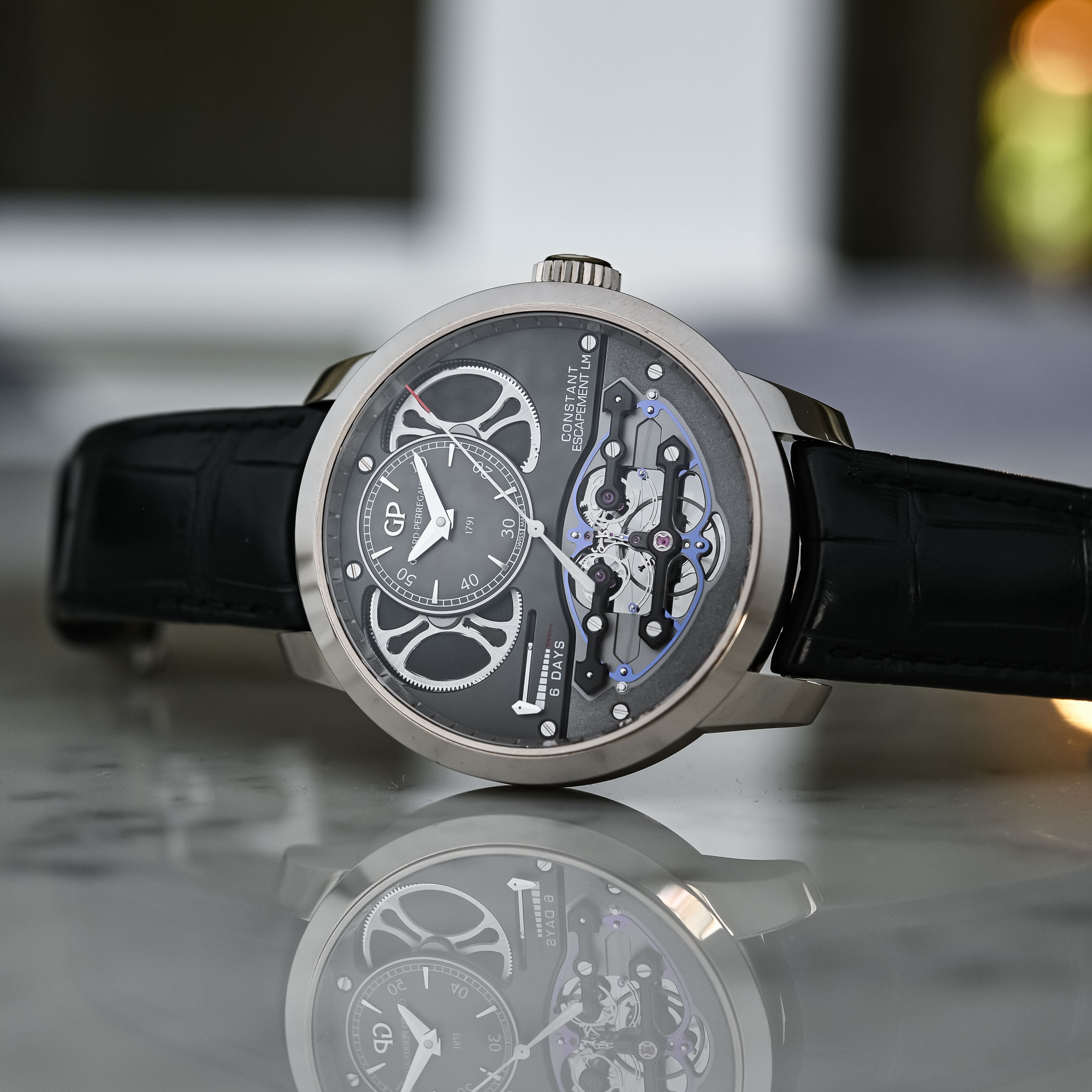
The use of modern technologies – DRIE for silicon parts and LIGA for pure nickel components – was instrumental in order to obtain satisfactory results, particularly with regard to engineering precision or elastic properties, tribology… To give an idea about the manufacturing precision, the constant escapement silicon buckled blade is just 14 microns, which is about 6 times thinner than a human hair!
In the meantime, Nicolas Déhon had left Girard-Perregaux to join Patek Philippe (2008-2017), where he also filed patents for bi-stable mechanisms. He then made a comeback to Girard-Perregaux, where he filed new patents on the Constant Escapement – EP3599514A1 in 2018. He has now been working for Breitling since 2021. It would be difficult to list the names of all the watchmakers that have worked on the project. We’ll mention Stéphane Oes, who took over from Déhon as he first left to Patek Philippe to develop the first movements, Laurent Calame (laboratory watchmaker) and Matthieu Kummer, who has long been involved in the project and who is now in charge of its development.
The Girard-Perregaux Neo Constant Escapement
With its 2023 Neo Constant Escapement, this fascinating watch has evolved in every way, both technically and aesthetically. If, at first glance, not much seems to have changed from a technical perspective, the Neo Escapement integrates substantial evolutions. Of course, the fundamental principle remains unchanged, but the interactions with the buckled-blade/bi-stable structure are significantly modified.
The two escapement wheels are now two smaller stars fitted with 3 teeth (matching the 3Hz frequency). The lower radius allows for a larger force that is now transferred to the buckled blade via two new rocking levers. As the two wheels rotate in the same direction, these are asymmetrical. In particular, the goal of this new arrangement is to avoid the sliding frictions seen with the previous escapement wheels. Interestingly, 2 wheels very similar to these previous escapement wheels have been kept, but they have an inertial function only (more information on this below).
The escapement choreography is a complex sequence and has significantly evolved. As the balance wheel swings in its free arc, one of the escapement wheels pushes its rocking lever. This allows to accumulate energy in the buckled blade until it is almost ready to flip. The locking lever ensures that the system is locked. As the roller engages with the central lever’s fork, it gets the blade to flip. As the blade flips, it provides an impulse to the balance wheel. The escapement is then freed. To ensure a smooth sequence, the inertia wheel ensures that there is a slight delay before the escapement wheel restarts and pushes further its lever. Doing so, it positions the second rocking lever in front of the second escape wheel. The latter will then take over to accumulate energy in the blade and start another sequence all over again.
These improvements allow for a much higher efficiency for the Constant Escapement. The minimum power reserve is now guaranteed at 7 days (with the same barrels as before and despite a larger, heavier balance wheel). This arrangement also allows the escapement to be self-starting. Last, all Neo Constant Escapement watches are certified by the COSC – which besides the precision-related matter is also a sign that the concept seems mature enough to go into serial production. From the initial “tick-tock” of the prototype to the Neo Constant Escapement, the project was staked out by a long series of steps and rebounds. But such a project does require perseverance. The development of a new escapement is a really complex endeavour… it took decades to optimize the Swiss lever escapement.
As with the previous versions of the Constant Escapement, the use of cutting-edge technology was crucial. While back in 2008, the first silicon parts were made with CSEM in Neuchatel, the technical partner for silicon components is now Sigatec, a company that is jointly owned by Mimotec and Sowind Group, the parent company of Girard-Perregaux and Ulysse Nardin.
Besides the technical aspect, the Neo Constant Escapement also looks different. Of course, it has never resembled any other watch with its openwork design showing up the large silicon escapement spring and the fascinating undulations of its microscopic blade. Its fascinating symmetrical architecture now shares the design language of the contemporary members of the Bridges collection. The case is now 45mm, which is much more wearable than the previous 48mm diameter. Made of grade 5 titanium, it features a large box-shaped sapphire crystal granting lateral views on the dial and movement. The time indications are no longer offset but are displayed at the centre of the watch.
The hand-wound caliber GP09200 still features 2 barrels. It is dressed in a combination of black PVD and anthracite NAC, and the shape of the escapement bridges has adopted the brand’s modern “Neo” shape. The linear power reserve indicator at 9 o’clock displays how much autonomy is left. Turning the watch over, the exhibition caseback allows you to discover the other side of the calibre. It is simply beautiful too, with its silver-tone in-line going train and symmetrical design.
The Girard-Perregaux Neo Constant Escapement is presented on a fabric-like rubber strap. The triple-folding buckle is fitted with a micro-adjustment system. The watch is not a limited edition, but production will be limited by the complexity of the product. The price is set at EUR 105,000. For more information, please visit www.girard-perregaux.com.


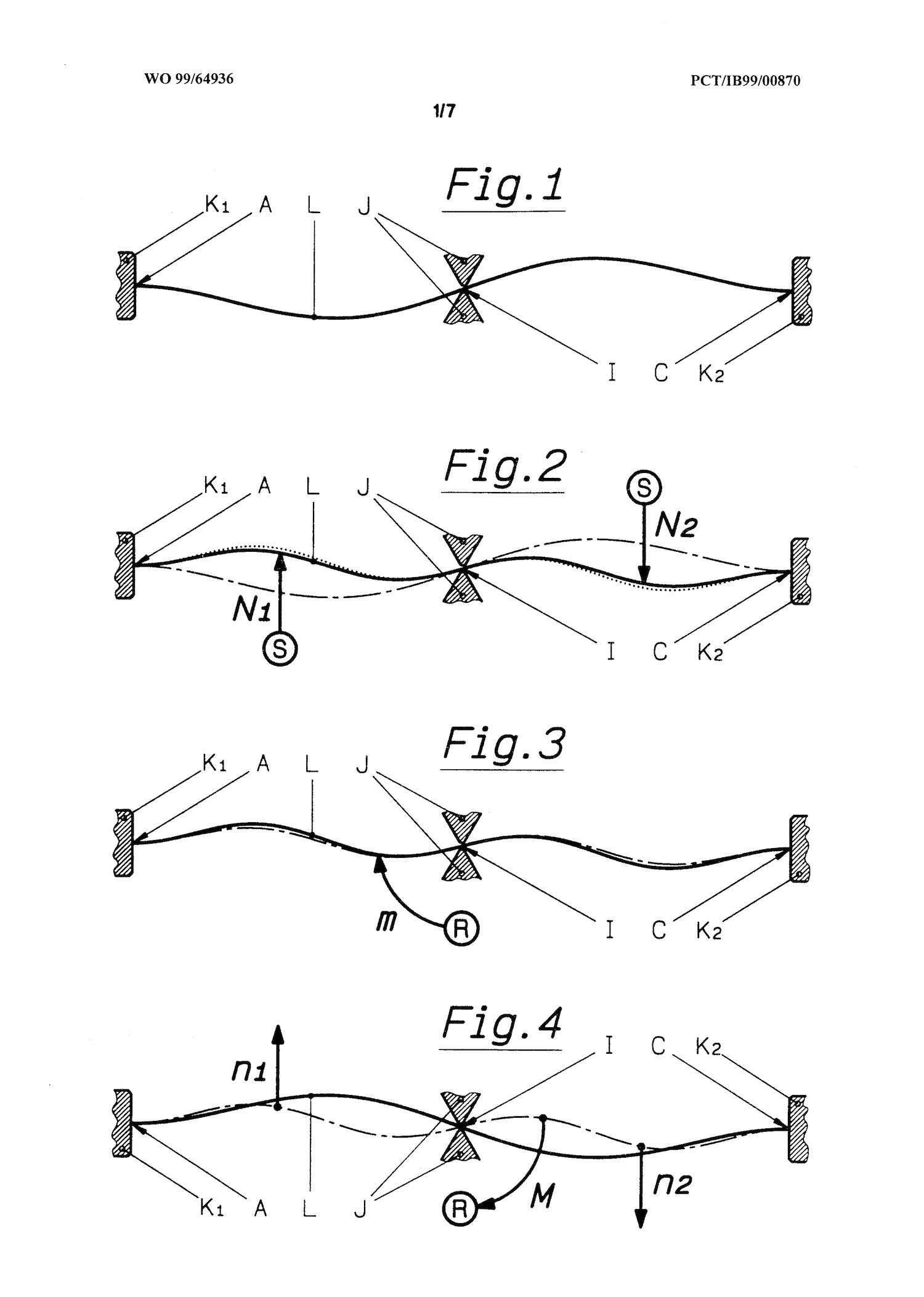


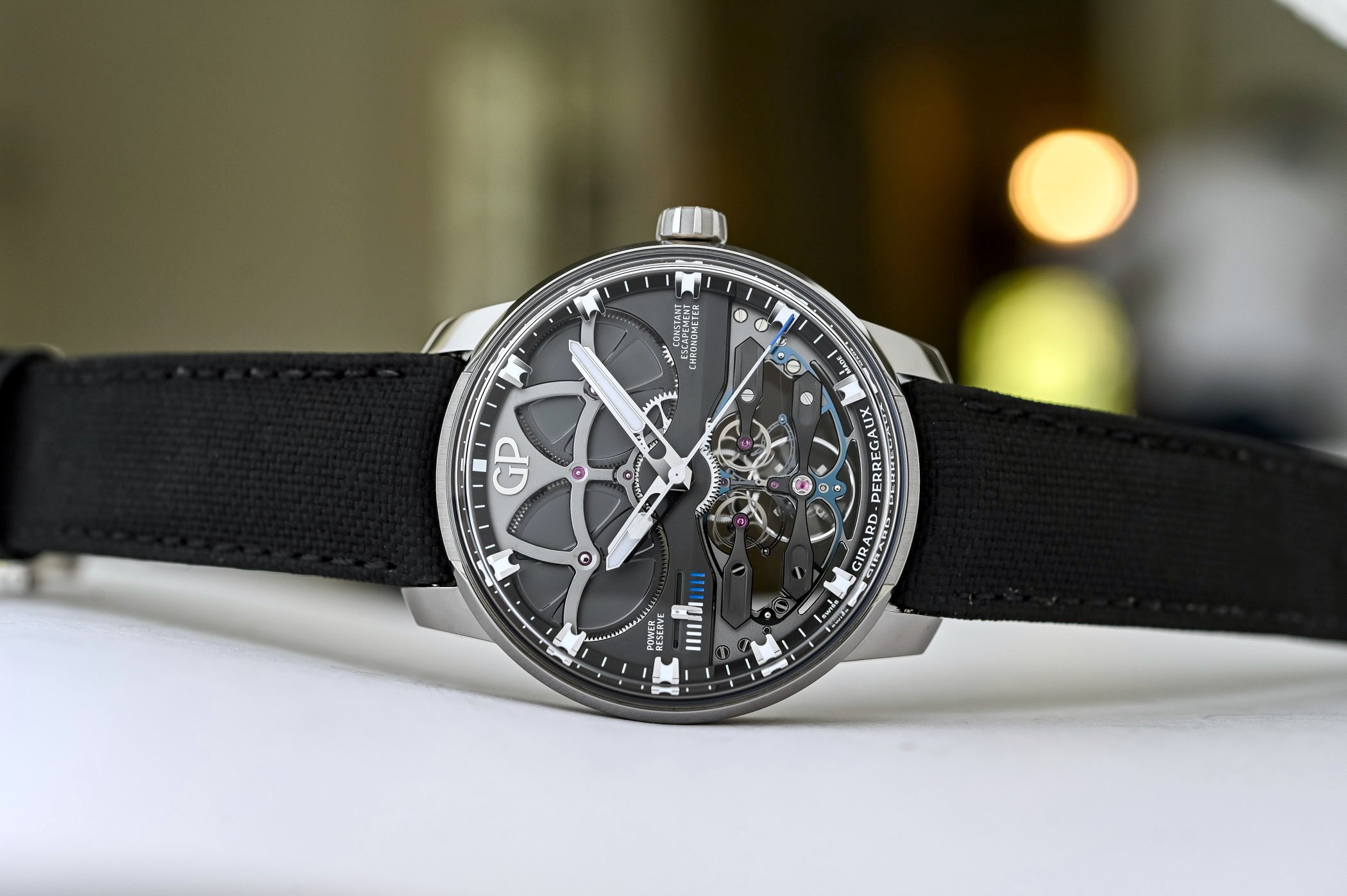
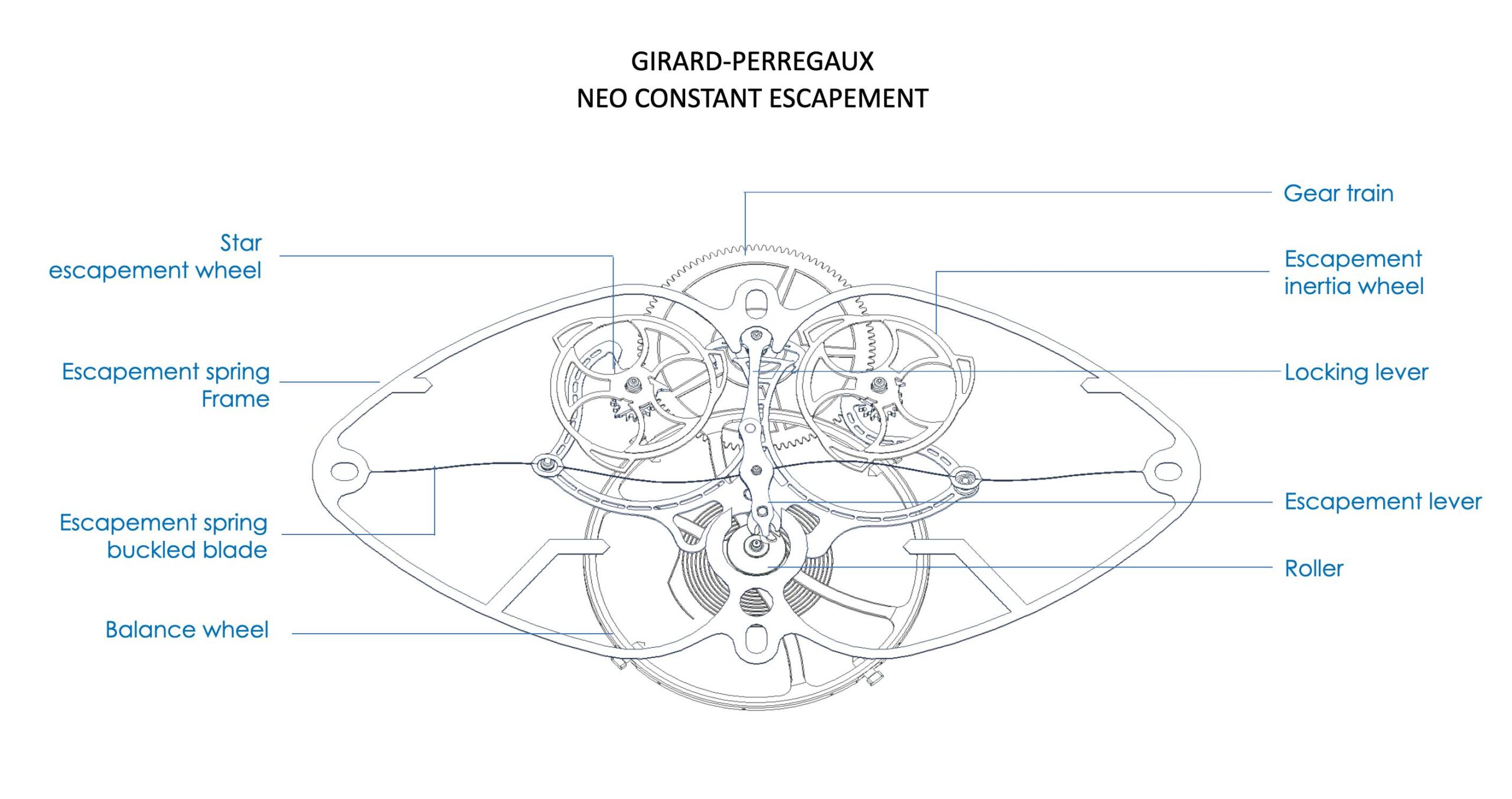



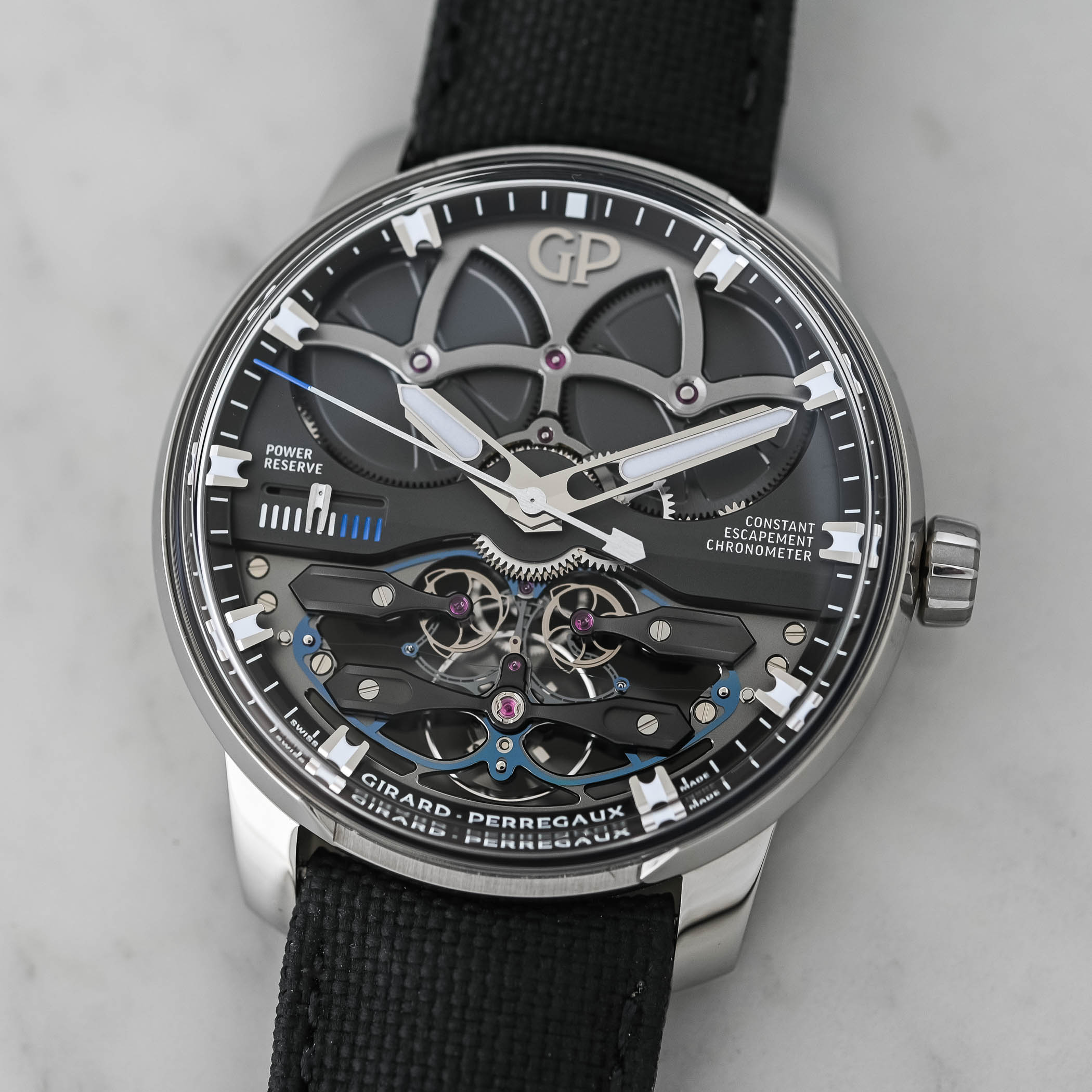

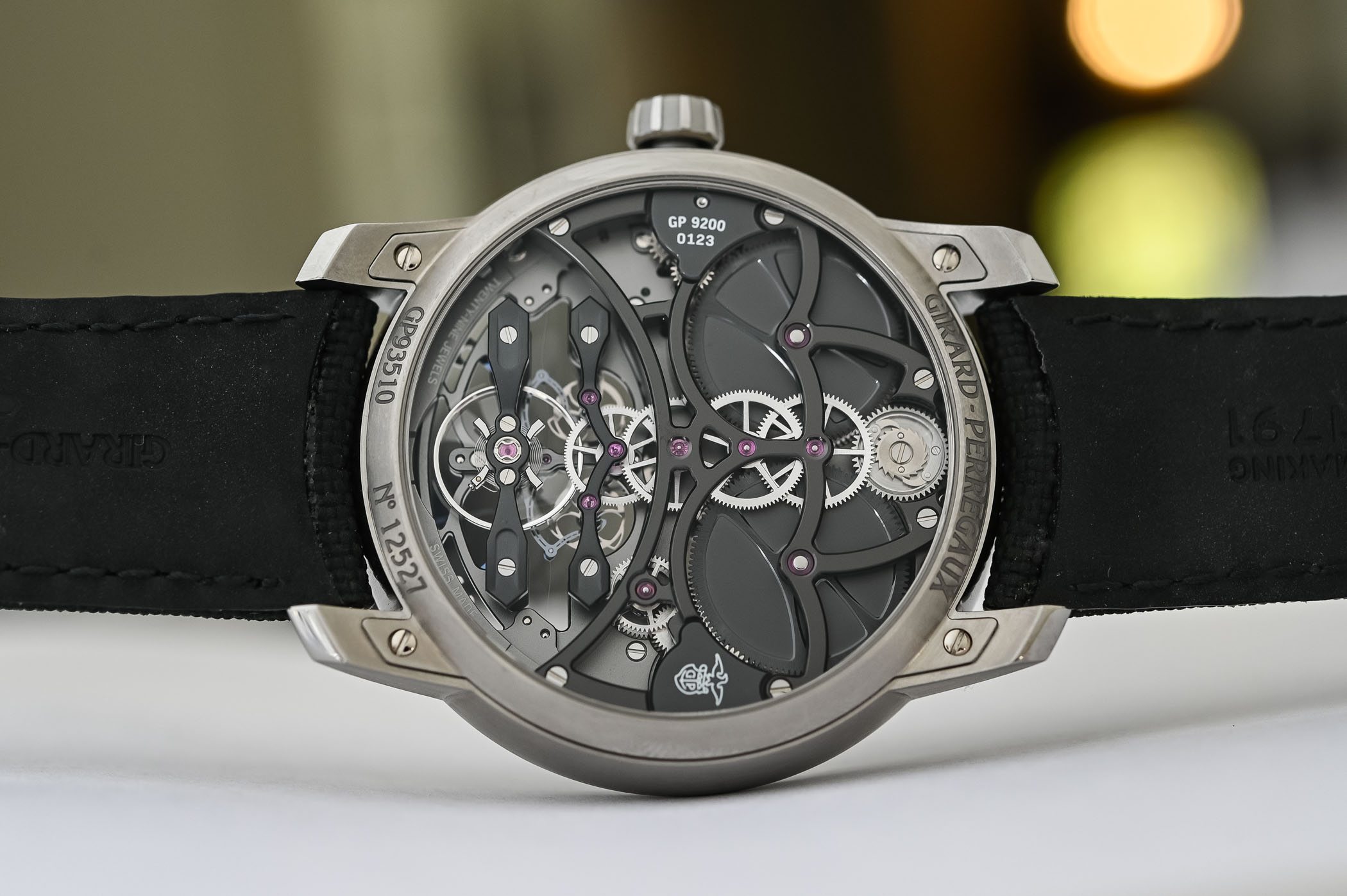
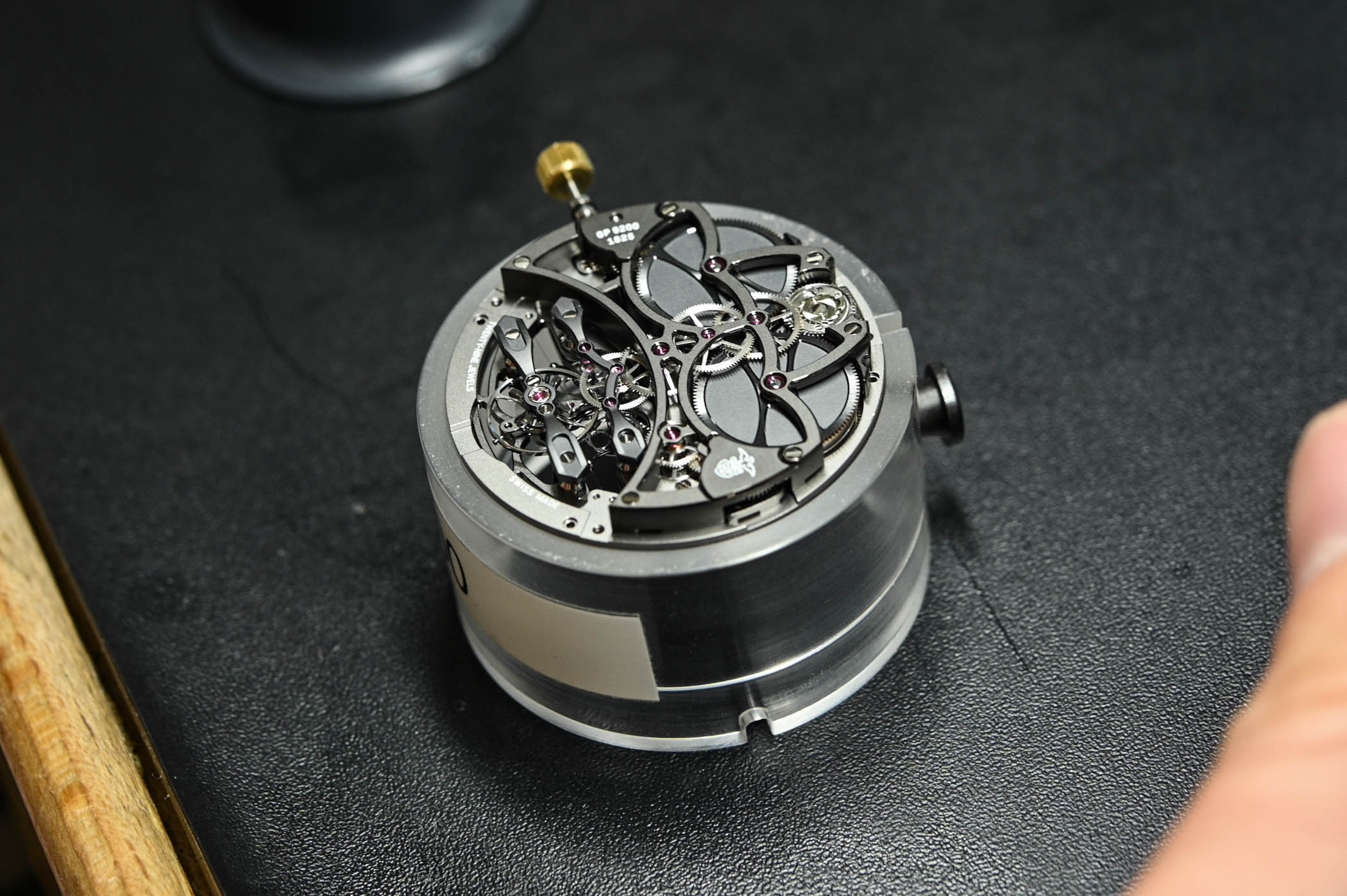
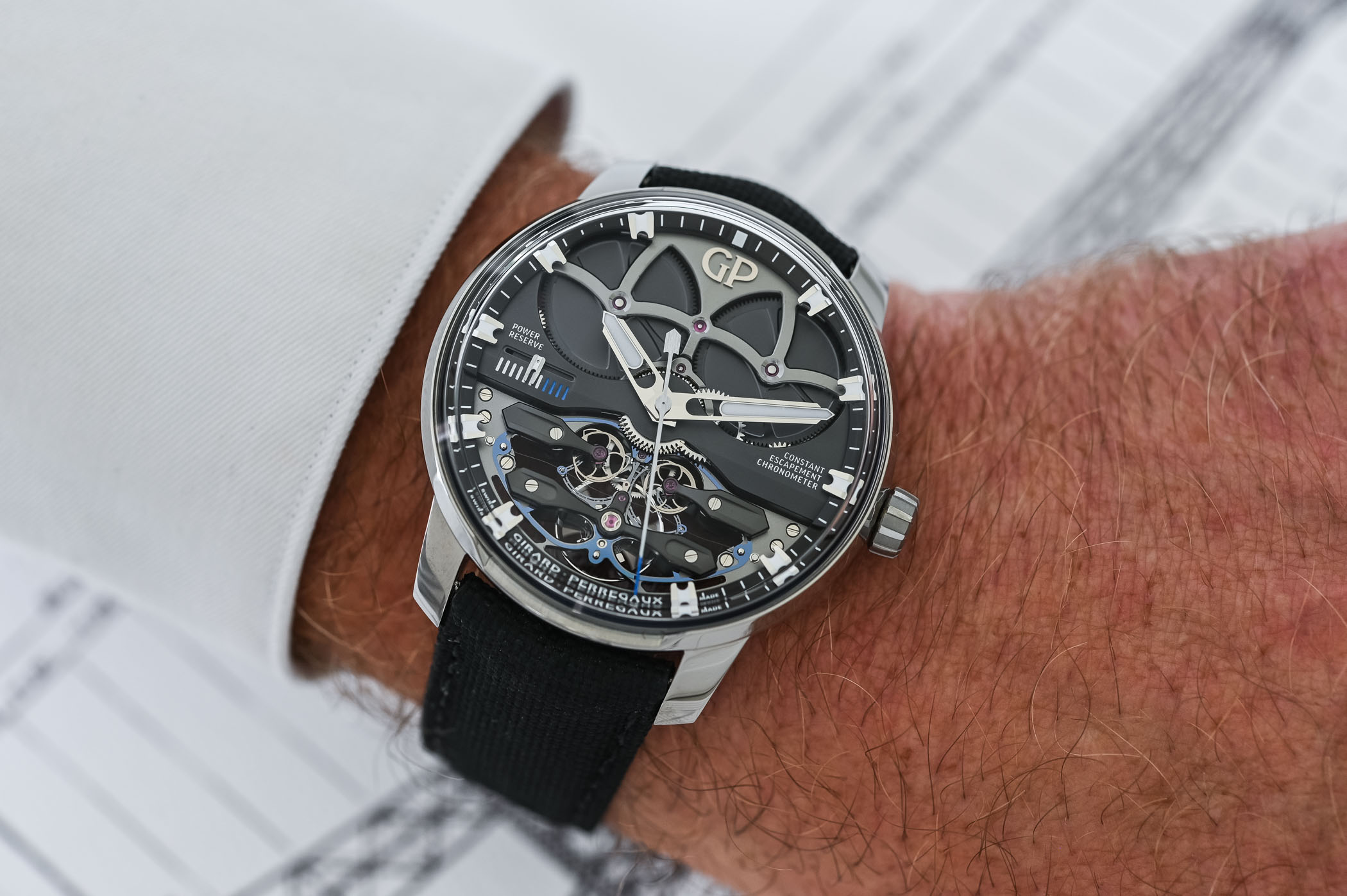



9 responses
Fascinating article and video, thanks for sharing. The watch is super cool, hopefully they’ll be able to shrink the case shape in future, 45mm is just a bit too chunky for me.
ciao Xavier, thanks for this comprehensive article, GP is an underrated brand I love. However it is great to see that despite company changes and difficulties they were able to stick to the constant escapment project. It has to me the same potential of the coaxial escapment in terms of innovation and possibility to be widespread applied to all GP portfolio. Maybe next step is further miniaturization since the caliber appears to be quite big (as consequently is the watch).
Best regards,
Andrea
Thanks – indeed great to see GP perseverance with the Constant Escapement. Seeing this new version has been an excellent surprise. @andrea I doubt there is much room for a miniaturized CE, hence for widespread utilization (because of its size and complexity), it will most likely remain a more confidential production than the Coaxial escapement which has long been « industrialized ». Still truly fascinating to me.
Cher Xavier,
Merci et bravo pour ce reportage !
25 ans se sont écoulées depuis l’idée initiale !
Que le temps passe vite, même si le presque milliard de secondes écoulées durant toutes ces belles années furent égrenées de manière aussi contantes que possible…
En espérant que les connaisseurs sauront voir en ce produit abouti l’œuvre d’hommes tout autant passionnés que persévérants.
Longue vie à l’Échappement Constant et sincères félicitations à Girard Perregaux d’y avoir cru tout autant que moi.
Great article! Thank you for telling the entire history and especially for highlighting the inventor.
This escapement is unique since it is the only one which is entirely original and not derived from previous designs. For example, the coaxial escapement is derived from the Robin escapement (1791) which is itself derived from the detent escapement (1748).
-ilan
All I can say is WOW. Haven’t been this impressed with a watch movement in a very long time.
It seems a lot of work with no significant advantage over the current escapement in use today. When I see 0 – 0 – 0 – 0 – 0 – 0 in all five positions when calibrating I will buy it…
Just an amazing article and we are so glad that industry still have peopel pushing for the best with new material and new technology.
Keep up the great work
Kal | Samurai Vintage
Really a great work of a watch, with interesting technology and a cohesive (and attractive) design language. Girard Perregaux’s exceptional work with this line and the “entry level” Neo Bridges and Sky Bridges has been underappreciated by collectors.
Unlike some other blade-based tech, chronometer certification is achieved. The price is high though. In five years, this branch tech might be surpassed by something coming from Frederique Constant, but what will remain is an attractive showcase watch.
Secondary market prices on these pieces will be worth following, if you’re a serious collector.